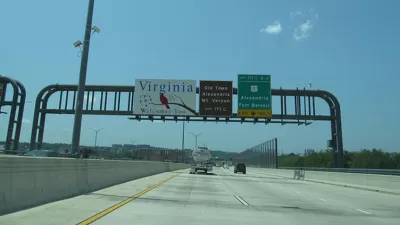Virginia opened 29 miles of high-occupancy toll lanes to business on December 29 of 2014. What lessons are drivers and policy makers taking from the ongoing test of the concept?
Washington Post columnist Robert Thomson examines the theory behind high-occupancy toll (HOT) lanes, especially as recently scaled-up to a new degree by 29 miles of HOT lanes of interstates 95 and 395 in Virginia.
"It’s too soon to know whether the lanes will achieve the lofty goals for traffic relief set by their proponents," writes Thomson. "But the concerns raised by early adapters to life in the HOT lanes provide some indication of what happens when paper theory meets pavement."
The article also sets the context of the national conversation about transportation funding and the state of Virginia's potential expansion of HOT lanes to Interstate 66. To address those possibilities with the I-95 and I-395 HOT lanes as a case study, Thomson goes on to examine "five of the top issues drivers are raising about the new I-95 HOT lanes."
Those five issues are summed up here, with lots more details in the article:
- The transition zone.
- Knowing the toll.
- Are they ever free?
- Is it worth it?
- Are carpoolers protected?
FULL STORY: Virginia’s HOT lanes could be the future of U.S. transportation

Manufactured Crisis: Losing the Nation’s Largest Source of Unsubsidized Affordable Housing
Manufactured housing communities have long been an affordable housing option for millions of people living in the U.S., but that affordability is disappearing rapidly. How did we get here?

Americans May Be Stuck — But Why?
Americans are moving a lot less than they once did, and that is a problem. While Yoni Applebaum, in his highly-publicized article Stuck, gets the reasons badly wrong, it's still important to ask: why are we moving so much less than before?

Using Old Oil and Gas Wells for Green Energy Storage
Penn State researchers have found that repurposing abandoned oil and gas wells for geothermal-assisted compressed-air energy storage can boost efficiency, reduce environmental risks, and support clean energy and job transitions.

Updating LA’s Tree Rules Could Bring More Shade to Underserved Neighborhoods
A new USC study finds that relaxing Los Angeles’ outdated tree planting guidelines could significantly expand urban tree canopy and reduce shade disparities in lower-income neighborhoods, though infrastructure investments are also needed.

California's Canal Solar Projects Aim to Conserve Resources and Expand Clean Energy
California’s Project Nexus has begun generating electricity from solar panels installed over irrigation canals, with researchers and state agencies exploring statewide expansion to conserve water and boost clean energy production.

HHS Staff Cuts Gut Energy Assistance Program
The full staff of a federal program that distributes heating and cooling assistance for low-income families was laid off, jeopardizing the program’s operations.
Urban Design for Planners 1: Software Tools
This six-course series explores essential urban design concepts using open source software and equips planners with the tools they need to participate fully in the urban design process.
Planning for Universal Design
Learn the tools for implementing Universal Design in planning regulations.
Heyer Gruel & Associates PA
City of Moreno Valley
Institute for Housing and Urban Development Studies (IHS)
City of Grandview
Harvard GSD Executive Education
Salt Lake City
NYU Wagner Graduate School of Public Service
City of Cambridge, Maryland



























